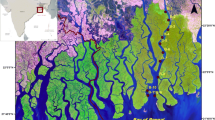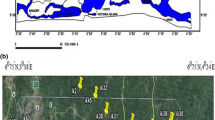Abstract
Sediments collected from the River Buriganga were analyzed by using ICP-MS for spatial (site-to-site) and seasonal variations of a large number of elements, as many as 48. Out of these elements, 15 elements were given more attention because of their detrimental effects on human health and aquatic lives. These 15 elements are V, Cr, Mn, Ni, Cu, Zn, As, Se, Mo, Cd, Ba, Hg, Pb, Bi and U, and their mean concentrations were 7.51 ± 2.25, 39.70 ± 18.84, 37.58 ± 3.13, 6.39 ± 0.96, 14.07 ± 15.93, 36.73 ± 34.38, 0.18 ± 0.12, 1.07 ± 0.05, 0.40 ± 0.09, 0.21 ± 0.02, 20.80 ± 2.21, 0.016 ± 0.001, 10.41 ± 13.61, 0.33 ± 0.02 and 0.45 ± 0.09 mg/kg in monsoon, respectively; the mean concentrations in winter were 8.66 ± 2.77, 41.45 ± 15.88, 39.06 ± 2.72, 7.14 ± 1.11, 15.93 ± 18.38, 40.71 ± 37.33, 0.21 ± 0.13, 1.19 ± 0.05, 0.44 ± 0.11, 0.23 ± 0.03, 23.09 ± 2.63, 0.018 ± 0.001, 11.40 ± 15.09, 0.36 ± 0.02 and 0.50 ± 0.11 mg/kg, respectively. These results indicate that concentrations of the studied elements were almost the same in both the seasons. However, the concentrations were slightly higher in winter than those in monsoon with respect to spatial variation. The higher concentrations of Cr in both the seasons were due to direct discharge of tanning effluents for a long time. Values of contamination factor (Cf), degree of contamination (Cd), pollution load index and ecological risk potential (RI) factors for the selected toxic elements, i.e., Cr, Mn, Zn, Cu, Pb, Ni, Cd, As, Hg in the surface sediments, indicated that the contamination status in the studied area was low. The low contamination level may be due to steps taken by the authorities to prevent direct discharge of industrial effluents in the River Buriganga in the recent years.

Similar content being viewed by others
References
Ahmed MK, Islam S, Rahman S, Haque MR, Islam MM (2010) Heavy metals in water, sediment and some fishes of Buriganga River, Bangladesh. Int J Environ Res 4:321–332
Ahmed MK, Baki MA, Kundu GK, Islam MS, Islam MM, Hossain MM (2016) Human health risks from heavy metals in fish of Burigangariver, Bangladesh. Springer Plus 5:1697–1709
Akcay H, Oguz A, Karapire C (2003) Study of heavy metal pollution and speciation in Buyak Menderes and Gediz river sediments. Water Res 37(4):813–822
Alam AMS, Islam MA, Rahman MA, Siddique MN, Matin MA (2003) Comparative study of the toxic metals and non-metal status in the major river system of Bangladesh. Dhaka Univ J Sci 51:201–208
Banu Z, Chowdhury AMS, Hossain MD, Kenichi N (2013) Contamination and ecological risk assessment of heavy metal in the sediment of Turag River, Bangladesh: an index analysis approach. J Water Resour Prot 5:239–248
Belhadj M, Ghezzar MR, Abdelmalek F, Benhamed AA, Ouddane B, Addou A (2006) Assessment of the sediment contamination by heavy metals of the Chelif River, Algeria. Fresen Environ Bull 15(3):186–192
Das M, Ahmed MK, Islam MS, Islam MM, Akter MS (2011) Heavy metals in industrial effluents (Tanning and Textile) and adjacent rivers of Dhaka city, Bangladesh. Terr Aquat Environ Toxicol 5:8–13
Daskalakis KD, O’Connor TP (1995) Normalization and elemental sediment contamination in the coastal United States. Environ Sci Technol 29:470–477
Datta DK, Subramanian V (1998) Distribution and fractionation of heavy metals in the surface sediments of the Ganges–Brahmaputra–Meghna river system in the Bengal basin. Environ Geol 36:93–101
Forcada EG, Vega-Alegre M (2015) Arsenic, barium, strontium and uranium geochemistry and their utility as tracers to characterize groundwaters from the Espadán–Calderona Triassic Domain, Spain. Sci Total Environ 512–513:599–612
Fu F, Wang Q (2011) Removal of heavy metal ions from wastewaters: a review. J Environ Manag 92:407–418
Gupta A, Rai DK, Pandey RS, Sharma B (2009) Analysis of some heavy metals in the riverine water, sediments and fish from river Gangs at Allahabad. Environ Monit Assess 157(1–4):449–458
Hakanson L (1980) An ecological risk index for aquatic pollution control, a sedimentological approach. Water Res 14:975–1002
Hanson PJ, Evans DW, Colby DR (1993) Assessment of elemental contamination in estuarine and coastal environments based on geochemical and statistical modeling of sediments. Mar Environ Res 36:237–266
Hasan M, Rahman MATM, Saha B, Kamal AKI (2015) Status of heavy metals in water and sediment of the Meghna river, Bangladesh. Am J Environ Sci 11:427–439
Islam MS, Ahmed AK, Raknuzzaman M, Al-Mamun MH, Masunaga M (2015) Metal speciation in sediment and their bioaccumulation in fish species of three urban rivers in Bangladesh. Arch Environ Contam Toxicol 68:92–106
Karadede-Akin H, Unlu E (2007) Heavy metal concentrations in water, sediment, fish and some benthic organisms from Tigris river, Turkey. Environ Monit Assess 131(1–3):323–337
Karbassi AR, Monavari SM, Nabi BGR, Nouri J, Nematpour K (2008) Metal pollution assessment of sediment and water in the Shur river. Environ Monit Assess 147(1–3):107–116
Khan YSA, Hossain MS, Hossain SMGA, Halimuzzaman AHM (1998) An environment of trace metals in the GBM Estuary. Remote Sens Environ 2:103–113
Khan R, Shirai N, Ebihara M (2015) Chemical characteristic of R chondrites in the light of P, REEs, Th and U abundances. Earth Planet Sci Lett 422:18–27
Liu C, Xu J, Liu C, Zhang P, Dai M (2009) Heavy metals in the surface sediments in Lanzhou reach of Yellow river, China. Bull Environ Contam Toxicol 82(1):26–30
MacDonald DD, Ingersoll CG, Berger TA (2000) Development and evaluation of consensus-based sediment quality guidelines for freshwater ecosystems. Arch Environ Contam Toxicol 39(1):20–31
Maile FJ, Pfaff G, Reynders P (2005) Effect pigments-past, present and future. Prog Org Coat 54:150–163
Majumder RK, Faisal BMR, Zaman MN, Uddin MJ, Sultana N (2015) Assessment of heavy metals pollution in bottom sediment of the Buriganga river, Dhaka, Bangladesh by Multivariate Statistical Analysis. Int Res J Environ Sci 4(5):80–84
Mohiuddin KM, Ogawa Y, Zakir HM, Otomo K, Shikazono N (2011) Heavy metals contamination in water and sediments of an urban river in a developing country. Int J Environ Sci Technol 8:723–736
Morillo J, Usero J, Gracia I (2004) Heavy metal distribution in marine sediments from the southwest coast of Spain. Chemosphere 55:431–442
Mukai H, Tanaka A, Fujii T, Nakao M (1994) Lead isotope ratios of airborne particulate matter as tracers of long-range transport of air pollutants around Japan. J Geophys Res 99:3717–3727
Nargis A (2017) Assessment of multielement in water, sediment and fish species of the river Buriganga (Bangladesh) by inductively coupled plasma-mass spectrometry: ecological and human health risk evaluation. MS dissertation, Xiamen University, P. R. China
Ogbeibu AE, Omoigberale MO, Ezenwa MI, Eziza JO, Igwe IO (2014) Using pollution load index and geoaccumulation index for the assessment of heavy metal pollution and sediment quality of the Benin river. Nat Environ Nigeria 2:1–9
Persuad D, Jaagumagi R, Hayton A (1993) Guidelines for the protection and management of aquatic sediment quality in Ontario. Ontario Ministry of the Environment, Canada
Rahman MS, Saha N, Molla AH (2014) Potential ecological risk assessment of heavy meatl contamination in sediment and water body around Dhaka export processing zone, Bangladesh. Environ Earth Sci 71:2293–2308
Ramesh R, Ramanathan A, Ramesh S, Purvaja R, Subramanian V (2000) Distribution of rare earth elements and heavy metals in the surficial sediments of the Himalayan river system. Geochem J 34:295–319
Saha PK, Hossain MD (2011) Assessment of heavy metal contamination and sediment quality in the Burigangariver, Bangladesh. In: 2nd International conference on environmental science and technology, IPCBEE, 6. IACSIT Press, Singapore
Tomlinson DC, Wilson JG, Harris CR, Jeffrey DW (1980) Problems in the assessment of heavy-metal levels in estuaries and the formation of a pollution index. Helgol Mar Res 33:566–575
Uluturhan E, Kontas A, Can E (2011) Sediment concentrations of heavy metals in the Homa Lagoon (Eastern Aegean Sea): assessment of contamination and ecological risks. Mar Pollut Bull 62(9):1989–1997
US EPA (US Environmental Protection Agency) (1999) Screening level ecological risk assessment protocol for hazardous waste combination facilities, vol 3, Appendix E: Toxicity reference values. EPA 530-D99-001C. http://www.epa.gov/epaoswer/hazwaste/combust/eco-risk/volume3/appx-e.pdf. Accessed Nov 1999
Wang C, Niu Z, Li Y, Sun J, Wang F (2011) Study on heavy metal concentrations in river sediments through the total amount evaluation method. J Zhejiang Univ SCI A 12(5):399–404
Xing B, Yeneman PLM (1998) Microwave digestion for analysis of metals in soil. Commun Soil Sci Plant Anal 29(7&8):923–930
Yan N, Liu W, Xie H, Gao L, Han Y, Wang M, Li H (2016) Distribution and assessment of heavy metals in the surface sediment of Yellow river, China. J Environ Sci 39:45–51
Acknowledgements
Authors would like to thank Professor M. S. Ullah of the Department of Geography and Environment, University of Dhaka, for his help in the preparation of a map of the sampling area using ArcGIS software. Authors also would like to thank Dr. A. N. M. Al-Razee, Training Institute of Chemical Industries (TICI), Ghorashal, Narsingdi (Bangladesh), for calculating correlation matrix using statistical software (SPSS version 18.0, USA).
Author information
Authors and Affiliations
Corresponding author
Additional information
Editorial responsibility: Agnieszka Galuszka.
Electronic supplementary material
Below is the link to the electronic supplementary material.
Rights and permissions
About this article
Cite this article
Nargis, A., Sultana, S., Raihan, M.J. et al. Multielement analysis in sediments of the River Buriganga (Bangladesh): potential ecological risk assessment. Int. J. Environ. Sci. Technol. 16, 1663–1676 (2019). https://doi.org/10.1007/s13762-018-1822-8
Received:
Revised:
Accepted:
Published:
Issue Date:
DOI: https://doi.org/10.1007/s13762-018-1822-8




